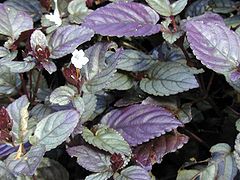Strobilanthes
| Strobilanthes subsp. var. | ||||||||||||||||||||||||||||||||||||||||||||||||||||||||
|---|---|---|---|---|---|---|---|---|---|---|---|---|---|---|---|---|---|---|---|---|---|---|---|---|---|---|---|---|---|---|---|---|---|---|---|---|---|---|---|---|---|---|---|---|---|---|---|---|---|---|---|---|---|---|---|---|

|
|
| ||||||||||||||||||||||||||||||||||||||||||||||||||||||
| ||||||||||||||||||||||||||||||||||||||||||||||||||||||||
Strobilanthes is a genus of about 250 species of flowering plants in the family Acanthaceae, mostly native to tropical Asia, but with a few species extending north into temperate regions of Asia.
| Standard Cyclopedia of Horticulture |
|---|
|
Strobilanthes (Greek, cone and flower, referring to the inflorescence). Acanthaceae. Herbs or shrubs, erect, sometimes tall, glabrous, scabrous-pubescent or villous; greenhouse, or out-of-doors in extreme South. Leaves opposite, in a few species strongly separated, entire or toothed: fls. blue, violet, or white, rarely yellow, solitary at the axils of the opposite bracts, sessile or short-pedicelled, sometimes in dense or interrupted terminal spikes or the peduncles clustered at the axils; calyx deeply 5-cleft or almost 5-parted, segms. linear; corolla-tube slender at the base, widened above; limb spreading, 5-lobed, lobes ovate; perfect stamens 4 or 2: caps. oblong or linear, 2-celled at or near the base.— About 200 species, India, Malaya, China, and Japan, also 1 in Trop. Afr. Adapted to the warmhouse. Strobilanthes are mostly erect half-shrubby plants cultivated for their flowers and foliage. Only young, well-grown plants are attractive, the older ones becoming weedy and unattractive. Some species are grown as ornamental foliage bedding plants, but they are not so desirable for general use as the coleus, the slightest cool weather changing the color of their leaves to a very undesirable shade. In the greenhouse they make fine decorative foliage plants but require at all times a high temperature and an abundance of moisture and much syringing. Under unfavorable conditions they lose then- leaves and become unsightly. S. auriculatus. Nees. Shrub, 2-6 ft. high, glabrous, except the more or less hairy tips of the branches: lvs., one sometimes 10 x 2 1/4 in., the other 3 x 1 1/2 in., ovate, serrulate: spikes terminal, solitary: fls. pale purple. India.—S. glomeratus, T. Anders. Shrub, with branches often horizontal and hairy upward: lvs. ovate and acute, complanate (flattened), serrate, hairy or villous above: fls. purple, about 2 in. long. India.—S. Wallichii, Nees. Weak subalpine shrub with angled branches: lvs. elliptic, acuminate: fls. blue, in pairs or solitary. Himalaya. CH
|
Cultivation
Propagation
Pests and diseases
Species
- Selected species
Gallery
-
photo 1
-
photo 2
-
photo 3
References
External links
- w:Strobilanthes. Some of the material on this page may be from Wikipedia, under the Creative Commons license.
- Strobilanthes QR Code (Size 50, 100, 200, 500)
